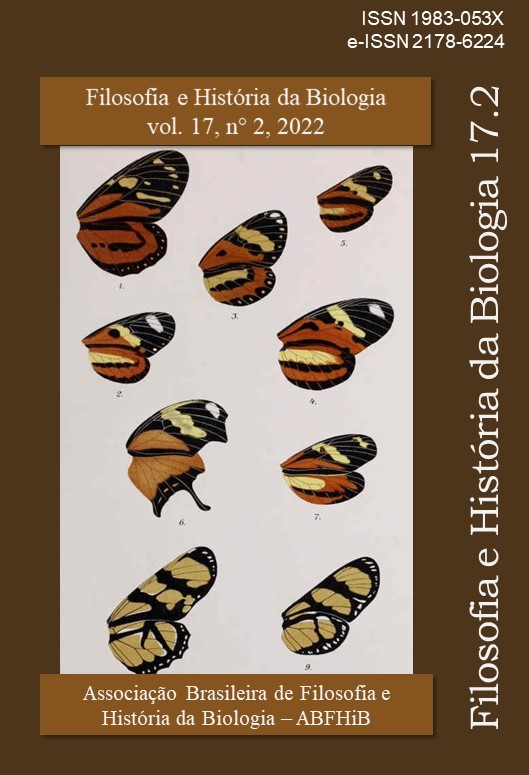To Bernard, what is Bernard’s: rescuing the meaning of “free life”
DOI:
https://doi.org/10.11606/issn.2178-6224v17i2p181-194Keywords:
Forms of Life, History of Physiology, Homeostasis, Internal Environment, VitalismAbstract
A recent critique on “homeostasis”, as elaborated by Walter Cannon (1871-1945), identifies contradictions intrinsic to the conditional association made by Claude Bernard (1813-1878) between “constancy of the internal environment” and “free life”. On the one hand, the critique reiterates the importance of the “internal environment” - the liquid where tissue cells live, extending to the evolution of the body’s fluid compartments. However, it also shows that the conditional association made by Bernard has neither empirical nor logical support. Therefore, assuming that “constancy of the internal environment” is the condition for “free life” is invalid. Apart from its intrinsic contradiction, other works have criticized the conditional on the assumption that Bernard, followed by Cannon, was referring to a rigid regulation of biological (life) variables in general. The objective of the present work is to show that this criticism is also invalid because, in our view, Bernard does not make this type of generalization when referring to “free life”. We conclude that avoiding ambiguities is necessary to appreciate Bernard’s theoretical contribution to physiology effectively.
References
ARMINJON, Mathieu. Birth of the allostatic model: from Can-non’s biocracy to critical physiology. Journal of the History of Biology, 49: 397-423, 2016. DOI: 10.1007/s10739-015-9420-9.
BERNARD, Claude. [1865]. An introduction to the study of experimental medicine Trad. H. C. Greene (MacMillan & Co. Ltd., 1927). New York, NY: Dover Publications, 1957.
BERNARD, Claude. Leçons sur les phénomènes de la vie communs aux animaux et aux végétaux. Tome I. Paris: J. B. Baillière et fils, 1878 (a).
BERNARD, Claude. [1878 (b)]. Lectures on the phenomena of life common to animals and plants. Vol. 1. Trad. H. E. Hoff; R. Guillemin; L. Guillemin. Springfield, Il: Charles C. Thomas Publisher Ltd., 1974.
CANNON, Walter Bradford. Organization for physiological homeostasis. Physiological Reviews, 09: 399-431, 1929. DOI: 10.1152/physrev.1929.9.3.399
COOPER, Steven J. From Claude Bernard to Walter Cannon. Emergence of the concept of homeostasis. Appetite, 51: 419-427, 2008. DOI: 10.1016/j.appet.2008.06.005
DE LUCA JÚNIOR, Laurival Antonio. A critique on the theory of homeostasis. Physiology and Behavior, 247: 113712, 2022 (a). DOI: 10.1016/j.physbeh.2022.113712.
DE LUCA JÚNIOR, Laurival Antonio. Defusing ambiguities in the theory of homeostasis: novel concepts demand demarcation of “regulation” and “internal environment”. Physiology and Behavior, 249: 113752, 2022 (b). DOI: 10.1016/j.physbeh.2022.113752.
DUTRA, Luiz Henrique de Araújo. A epistemologia de Claude Bernard. Campinas: Centro de Lógica, Epistemologia e História da Ciência, Universidade Estadual de Campinas, 2001. (Coleção CLE, 33)
GUPPY, Michael; WITHERS, Phillip. Metabolic depression in animals: physiological perspectives and biochemical generaliza-tions. Biological Reviews of the Cambridge Philosophical Society, 74: 1-40, 1999. DOI: 10.1017/s0006323198005258
HEITHAUS, Michael R.; DILL, Lawrence M. Does tiger shark predation risk influence foraging habitat use by bottlenose dol-phins at multiple spatial scales? Oikos, 114: 257-264, 2006. DOI: 10.1111/j.2006.0030-1299.14443.x
JANCZUR, Christine; ZAVAGLIA, Adriana; HADDAD, Hamilton; PRESTES, Maria Elice Brzezinski. Claude Bernard e a cons-tância do “meio interno”. Filosofia e História da Biologia, 8: 381-393, 2013. ISSN 1983-053X Disponível em: <https://www.abfhib.org/FHB/FHB-08-3/FHB-8-3-01-Christine-Janczur_Adriana-Zavaglia_Hamilton-Haddad_Maria-Elice-Brzezinski-Prestes.pdf>
JANCZUR, Christine; PRESTES, Maria Elice Brzezinski. Reflexões de Claude Bernard sobre o lugar da fisiologia experimental no debate vitalismo versus materialismo. Boletim de História e Filosofia da Biologia, 11: 4-10, 2017. Disponível em: <http://www.abfhib.org/Boletim/Boletim-HFB-11-n3-Set-2017.pdf>
KOEPPEN, Bruce M; STANTON, Bruce A. (eds.). Berne e Levy Fisiologia. 7ª Edição, Trad. S. I. de Oliveira. Rio de Janeiro, RJ: Elsevier, 2018. ISBN 9788535289138.
LENOIR, Timothy. The strategy of life. Dordrecht: D. Reidel Publish-ing Company, 1982. (Studies in the History of Modern Science, 13)
MARTINS, Lilian A.-C. Pereira. Lamarck e o vitalismo francês. Perspicillum, 9: 25-68, 1995.
MENDELSOHN, Everett. Physical models and physiological con-cepts: explanation in nineteenth-century biology. The British Jour-nal for the History of Science, 2: 201-219, 1965. DOI: 10.1017/S000708740000220X
MOORE-EDE, Martin Christopher. Physiology of the circadian timing system: predictive versus reactive homeostasis. American Journal of Physiology, 250: R737-R752, 1986. DOI: 10.1152/ajpregu.1986.250.5.R737
NORMANDIN, Sebastian. Claude Bernard and an introduction to the study of experimental medicine: “physical vitalism”, dialectic, and epistemology. Journal of the History of Medicine and Allied Sciences, 62: 495-528, 2007. DOI: 10.1093/jhmas/jrm015
PROSSER, Clifford Ladd. Perspectives of adaptation: theoretical aspects. Pp. 11-25, in: DILL, D. B.; ADOLPH, E. F.; WILBER, C. G. (eds.). Handbook of Physiology. Section 4: Adaptation to the Envi-ronment. Washington DC: American Physiological Society, 1964.
ROLL-HANSEN, Nils. Critical teleology: Immanuel Kant and Claude Bernard on the limitations of experimental biology. Jour-nal of the History of Biology, 9: 59-91, 1976. DOI: 10.1007/BF00129173.
SCHMIDT-NIELSEN, Knut. Fisiologia animal - adaptação e meio ambiente. Trad. T. Oppido; C. Finger. São Paulo, SP: Livraria Santos Editora, 1996.
STERLING, Peter. Allostasis: a model of predictive regulation. Physiology and Behavior, 106: 5-15, 2012. DOI: 10.1016/j.physbeh.2011.06.004
SULLIVAN, Mark D. Reconsidering the wisdom of the body: an epistemological critique of Claude Bernard’s concept of the in-ternal environment. The Journal of Medicine and Philosophy: A Forum for Bioethics and Philosophy of Medicine, 15: 493-514, 1990. DOI: 10.1093/jmp/15.5.493
TOUGERON, Kevin. Homeostasis theory: What can we learn from dormancy and symbiotic associations? Physiology and Behavior, 249: 113749, 2022. DOI: 10.1016/j.physbeh.2022.113749.
WAISSE, Silvia; AMARAL, Maria Thereza Cera Galvão do; ALFONSO-GOLDFARB, Ana Maria. Roots of French vitalism: Bordeu and Barthez, between Paris and Montpellier. História, Ciências, Saúde-Manguinhos, 18: 625-640, 2011. DOI: 10.1590/s0104-59702011000300002
WOLFE, Charles T. Vitalism and the resistance to experimentation on life in the eighteenth century. Journal of the History of Biology, 46: 255-282, 2013. DOI: 10.1007/s10739-012-9349-1

Downloads
Published
Issue
Section
License
Copyright (c) 2022 Filosofia e História da Biologia

This work is licensed under a Creative Commons Attribution-NonCommercial-ShareAlike 4.0 International License.
The published manuscripts become the property of the journal Philosophy and History of Biology, and the authors accept the terms of this license and agree to assign the copyright for publication, in addition to agreeing with the publication's commitment to offering open access to all of its content. The information and concepts issued in signed papers are the sole responsibility of their authors.

 cademia.edu
cademia.edu
